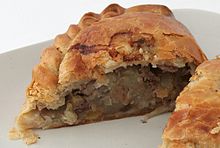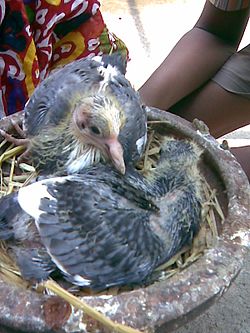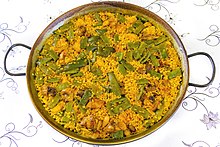F o o d
A portal dedicated to food and
foodways
Introduction


Food is any substance consumed by an organism for nutritional support. Food is usually of plant, animal, or fungal origin and contains essential nutrients such as carbohydrates, fats, proteins, vitamins, or minerals. The substance is ingested by an organism and assimilated by the organism's cells to provide energy, maintain life, or stimulate growth. Different species of animals have different feeding behaviours that satisfy the needs of their metabolisms and have evolved to fill a specific ecological niche within specific geographical contexts.
Omnivorous humans are highly adaptable and have adapted to obtain food in many different ecosystems. Humans generally use cooking to prepare food for consumption. The majority of the food energy required is supplied by the industrial food industry, which produces food through intensive agriculture and distributes it through complex food processing and food distribution systems. This system of conventional agriculture relies heavily on fossil fuels, which means that the food and agricultural systems are one of the major contributors to climate change, accounting for as much as 37% of total greenhouse gas emissions. ( Full article...)
Cooking, also known as cookery or professionally as the culinary arts, is the art, science and craft of using heat to make food more palatable, digestible, nutritious, or safe. Cooking techniques and ingredients vary widely, from grilling food over an open fire, to using electric stoves, to baking in various types of ovens, reflecting local conditions.
Preparing food with heat or fire is an activity unique to humans. Archeological evidence of cooking fires from at least 300,000 years ago exists, but some estimate that humans started cooking up to 2 million years ago.
The expansion of agriculture, commerce, trade, and transportation between civilizations in different regions offered cooks many new ingredients. New inventions and technologies, such as the invention of pottery for holding and boiling of water, expanded cooking techniques. Some modern cooks apply advanced scientific techniques to food preparation to further enhance the flavor of the dish served. ( Full article...)

KFC (also commonly referred to by its historical name Kentucky Fried Chicken) was founded by Colonel Harland Sanders, an entrepreneur who began selling fried chicken from his roadside restaurant in Corbin, Kentucky, during the Great Depression. Sanders identified the potential of restaurant franchising, and the first "Kentucky Fried Chicken" franchise opened in Salt Lake City, Utah, in 1952. KFC popularized chicken in the fast-food industry, diversifying the market by challenging the established dominance of the hamburger. Branding himself "Colonel Sanders", the founder became a prominent figure of American cultural history, and his image remains widely used in KFC advertising. The company's rapid expansion made it too large for Sanders to manage, so in 1964 he sold the company to a group of investors led by John Y. Brown Jr. and Jack C. Massey.
KFC was one of the first fast-food chains to expand internationally, opening outlets in Britain, Mexico, and Jamaica by the mid-1960s. Throughout the 1970s and 80s, KFC experienced mixed success domestically, as it went through a series of changes in corporate ownership with little or no experience in the restaurant business. In the early 1970s, KFC was sold to the spirits distributor Heublein, which was taken over by the R. J. Reynolds food and tobacco conglomerate, which later sold the chain to PepsiCo. The chain continued to expand overseas, and in 1987 KFC became the first Western restaurant chain to open in China. ( Full article...)
Selected article –
Sushi (すし, 寿司, 鮨, 鮓, pronounced [sɯɕiꜜ] or [sɯꜜɕi] ⓘ) is a Japanese dish of prepared vinegared rice (鮨飯, sushi-meshi), usually with some sugar and salt, plus a variety of ingredients (ねた, neta), such as vegetables, and any meat, but most commonly seafood (often raw but can be cooked). Styles of sushi and its presentation vary widely, but the one key ingredient is "sushi rice", also referred to as shari (しゃり), or sumeshi (酢飯).
The creator of modern sushi is believed to be Hanaya Yohei, who invented nigiri-zushi, a type of sushi most known today, in which seafood is placed on hand-pressed vinegared rice, around 1824 in the Edo period (1603–1867). It was the fast food of the chōnin class in the Edo period. ( Full article...)Selected cuisine -

Cornish cuisine encompasses the cooking styles, traditions and recipes associated with Cornwall and the Cornish people. It has been heavily influenced by the geography of the county as well as its social history.
Cornwall, being a peninsula surrounded by seas historically well-stocked with fish, has meant that fish dishes form a major part of the historical and modern recipes in Cornwall. The fishing industry has played a major part in the economy of the county. The iconic dish of Cornwall, the pasty, has its roots in another historical industry within the county, this being mining. ( Full article...)Selected ingredient –

In culinary terminology, squab is an immature domestic pigeon, typically under four weeks old, or its meat. Some authors describe it as tasting like dark chicken.
The word "squab" probably comes from Scandinavia; the Swedish word skvabb means "loose, fat flesh". The term formerly applied to all dove and pigeon species (such as the wood pigeon, the mourning dove, the extinct-in-the-wild socorro dove, and the now extinct passenger pigeon,) and their meat. More recently, squab meat comes almost entirely from domesticated pigeons. The meat of dove and pigeon gamebirds hunted primarily for sport is rarely called "squab". ( Full article...)
Selected recipe –
Paella ( /paɪˈɛlə/, /pɑːˈeɪjə/, py-EL-ə, pah-AY-yə, Valencian: [paˈeʎa], Spanish: [paˈeʝa]) is a rice dish originally from the Valencian Community. Paella is regarded as one of the community's identifying symbols. It is one of the best-known dishes in Spanish cuisine.
The dish takes its name from the wide, shallow traditional pan used to cook the dish on an open fire, paella being the word for a frying pan in Valencian language. As a dish, it may have ancient roots, but in its modern form, it is traced back to the mid-19th century, in the rural area around the Albufera lagoon adjacent to the city of Valencia, on the Mediterranean coast of Spain. ( Full article...)

George Constant Louis Washington [I] (May 20, 1871 – March 29, 1946) was a Belgian inventor and businessman. He is best remembered for his improvement of an early instant coffee process and for the company he founded to mass-produce it, the G. Washington Coffee Company.
An emigrant from his native Belgium, he arrived in the New York area in 1897. He dabbled in several technical fields before hitting upon manufacturing an adapted version of the nascent instant coffee, during a sojourn in Central America in 1906 or 1907. He began selling his coffee in 1909 and founded a company to manufacture it in 1910. Based in New York and New Jersey, his company prospered and became an important military supplier during World War I. The company's products were also advertised in New York newspapers and on the radio. The success of his company made Washington wealthy, and he lived in a mansion in Brooklyn and then moved to a country estate in New Jersey in 1927. In that same year, he lost a dispute with the tax authorities. Washington was married and had three children. ( Full article...)Selected image –

Selected biography –
B. 10 August 1814 – d. 7 July 1890
Henri Nestlé (French pronunciation: [ɑ̃ʁi nɛsle]; born Heinrich Nestle, German: [ˈhaɪnrɪç ˈnɛstlə]; 10 August 1814 – 7 July 1890) was a German-Swiss confectioner and the founder of Nestlé, the world's largest food and beverage company. ( Full article...)
Did you know (auto-generated) –

- ... that the Sonoran blue butterfly uses Dudleya cymosa subsp. pumila as a larval foodplant and hummingbirds feed on its nectar?
- ... that after George Alexander Albrecht collapsed when conducting Beethoven's Ninth Symphony during a New Year's concert, he returned to composing and began hospice work?
- ... that environmental activist Nigel Savage created Hazon after googling "Jewish food movement" and receiving zero search results?
- ... that Rosalind Creasy wrote a landmark book on edible landscaping?
- ... that Juan José Cabezudo was an openly gay chef and street-food seller in 19th-century Lima?
- ... that a British supermarket uses barriers to prevent shoppers grabbing food with yellow discount stickers out of the hands of staff?
More did you know –
Related portals
Food topics
The following are topics relating to food
Categories
Food list articles
- See also: Lists of foods and Category:Lists of drinks
The following are some Food list articles on Wikipedia:

- American cheeses
- Appellation d'Origine Contrôlée cheeses
- Apple cultivars
- Bacon dishes
- Bacon substitutes
- Basil cultivars
- Breads
- Breakfast beverages
- Breakfast cereals
- Breakfast foods
- British cheeses
- Cakes
- Candies
- Cheeses
- Cheese soups
- Christmas dishes (list)
- Cocktails
- Cookies
- Dishes using coconut milk
- Diets
- Doughnut varieties
- Egg dishes
- Fermented soy products
- Food additives
- Food additives (Codex Alimentarius)
- Foods named after people
- French cheeses
- French dishes
- Fried dough foods
- Fruits
- List of hamburgers
- Herbs and spices
- Hors d'oeuvre
- Indian dishes
- Indian snack foods
- Indonesian dishes
- Italian dishes
- Japanese snacks
- Japanese dishes
- Jewish dishes
- Kebabs
- Korean beverages
- Mango cultivars
- Moroccan dishes
- Pasta
- Pastries
- Philippine snack food
- Pies, tarts and flans
- Poppy seed pastries and dishes
- Potato dishes
- Puddings
- Raw fish dishes
- Rice dishes
- Rolled foods
- Sauces
- Seafood
- Seeds
- Sandwiches
- Snack foods
- Soft drinks by country
- Soul foods and dishes
- Soups
- Stews
- Street foods
- Tapas
- Turkish dishes
- Twice-baked foods
- Vegetable oils
- Vegetables
- Vodkas
Things you can do
Related WikiProjects
| Parent project: WikiProject Food and Drink | |
| Child projects: | Task forces: (All inactive) |
|
|
| Related projects: | |
New articles
Rules | Match log | Results page (for watching) | Last updated: 2024-04-29 19:19 (UTC)
Note: The list display can now be customized by each user. See List display personalization for details.
- Kōki Saitō ( | talk | history | links | watch | logs | tools) by Cynikles ( talk · contribs · new pages (1)) started on 2024-04-29, score: 10
- 24 in 24: Last Chef Standing ( | talk | history | links | watch | logs | tools) by TristanQuinn ( talk · contribs · new pages (2)) started on 2024-04-29, score: 10
- La Mejor Bakery ( | talk | history | links | watch | logs | tools) by BaduFerreira ( talk · contribs · new pages (10)) started on 2024-04-29, score: 20
- Wilson Davis ( | talk | history | links | watch | logs | tools) by Vycl1994 ( talk · contribs · new pages (19)) started on 2024-04-28, score: 10
- Sweet Rose Creamery ( | talk | history | links | watch | logs | tools) by TrademarkedTWOrantula ( talk · contribs · new pages (5)) started on 2024-04-28, score: 10
- Hunters Palm Springs ( | talk | history | links | watch | logs | tools) by Another Believer ( talk · contribs · new pages (156)) started on 2024-04-28, score: 10
- Haitian spaghetti ( | talk | history | links | watch | logs | tools) by Valereee ( talk · contribs · new pages (9)) started on 2024-04-27, score: 10
- Artocarpus styracifolius ( | talk | history | links | watch | logs | tools) by Ulathijau ( talk · contribs · new pages (2)) started on 2024-04-27, score: 10
- Atomo ( | talk | history | links | watch | logs | tools) by White 720 ( talk · contribs · new pages (2)) started on 2024-04-27, score: 30
- Lauren Rudolph E. coli case ( | talk | history | links | watch | logs | tools) by Margaretdonnelly ( talk · contribs · new pages (1)) started on 2024-04-23, score: 10
- Ruditapes philippinarum ( | talk | history | links | watch | logs | tools) by Sjl197 ( talk · contribs · new pages (1)) started on 2024-04-27, score: 10
- Bonèt ( | talk | history | links | watch | logs | tools) by Frankserafini87 ( talk · contribs · new pages (3)) started on 2024-04-26, score: 20
- Ganmianpi ( | talk | history | links | watch | logs | tools) by Iuliusnanus ( talk · contribs · new pages (8)) started on 2024-04-25, score: 10
- D'Ambrosio Gelato ( | talk | history | links | watch | logs | tools) by Another Believer ( talk · contribs · new pages (156)) started on 2024-04-25, score: 10
- Murcian meat pie ( | talk | history | links | watch | logs | tools) by ChampClancy ( talk · contribs · new pages (1)) started on 2024-04-24, score: 20
- Full Tilt Ice Cream ( | talk | history | links | watch | logs | tools) by Another Believer ( talk · contribs · new pages (156)) started on 2024-04-24, score: 10
- Roger Hugo ( | talk | history | links | watch | logs | tools) by NouveauSarfas ( talk · contribs · new pages (1)) started on 2024-04-24, score: 10
- Gelatiamo ( | talk | history | links | watch | logs | tools) by Another Believer ( talk · contribs · new pages (156)) started on 2024-04-24, score: 10
- Paratrophis banksii ( | talk | history | links | watch | logs | tools) by Tom Radulovich ( talk · contribs · new pages (153)) started on 2024-04-23, score: 10
- Dumb bread ( | talk | history | links | watch | logs | tools) by LittleT889 ( talk · contribs · new pages (14)) started on 2024-04-23, score: 10
- Frankie & Jo's ( | talk | history | links | watch | logs | tools) by Another Believer ( talk · contribs · new pages (156)) started on 2024-04-23, score: 10
- List of food and drink monuments ( | talk | history | links | watch | logs | tools) by Altenmann ( talk · contribs · new pages (71)) started on 2024-04-23, score: 20
- Ko Omm ( | talk | history | links | watch | logs | tools) by Sattwaikyaw ( talk · contribs · new pages (1)) started on 2024-04-22, score: 10
- Nourishing Hope ( | talk | history | links | watch | logs | tools) by Raearutherford ( talk · contribs · new pages (1)) started on 2024-04-16, score: 10
- Rachel's Ginger Beer ( | talk | history | links | watch | logs | tools) by Another Believer ( talk · contribs · new pages (156)) started on 2024-04-22, score: 10
- Crisp pork ( | talk | history | links | watch | logs | tools) by チャリス ( talk · contribs · new pages (8)) started on 2024-04-22, score: 20
- "Flower" tofu ( | talk | history | links | watch | logs | tools) by チャリス ( talk · contribs · new pages (8)) started on 2024-04-22, score: 10
- Taro pastry ( | talk | history | links | watch | logs | tools) by Heeheemalu ( talk · contribs · new pages (14)) started on 2024-04-22, score: 10
- Garbage Plate ( | talk | history | links | watch | logs | tools) by BanjoZebra ( talk · contribs · new pages (5)) started on 2024-04-10, score: 40
- Morning in America (EP) ( | talk | history | links | watch | logs | tools) by OttoJohn ( talk · contribs · new pages (1)) started on 2024-04-21, score: 10
- Mike's Hot Honey ( | talk | history | links | watch | logs | tools) by BanjoZebra ( talk · contribs · new pages (5)) started on 2024-04-21, score: 40
- Zajiangmian ( | talk | history | links | watch | logs | tools) by チャリス ( talk · contribs · new pages (8)) started on 2024-04-21, score: 20
- Cannabis in the restaurant industry ( | talk | history | links | watch | logs | tools) by Another Believer ( talk · contribs · new pages (156)) started on 2024-04-21, score: 10
- Kentrell Barkley ( | talk | history | links | watch | logs | tools) by Skyggestadium ( talk · contribs · new pages (7)) started on 2024-04-21, score: 10
- Coffee Talk Episode 2: Hibiscus & Butterfly ( | talk | history | links | watch | logs | tools) by JuniperChill ( talk · contribs · new pages (11)) started on 2024-04-20, score: 20
- Dough Joy ( | talk | history | links | watch | logs | tools) by Another Believer ( talk · contribs · new pages (156)) started on 2024-04-20, score: 20
- Chicken galantina ( | talk | history | links | watch | logs | tools) by Obsidian Soul ( talk · contribs · new pages (36)) started on 2024-04-19, score: 20
- Ponche Navideño ( | talk | history | links | watch | logs | tools) by Valereee ( talk · contribs · new pages (9)) started on 2024-04-19, score: 20
- Lengua estofado ( | talk | history | links | watch | logs | tools) by Obsidian Soul ( talk · contribs · new pages (36)) started on 2024-04-19, score: 20
- PDX671 ( | talk | history | links | watch | logs | tools) by Another Believer ( talk · contribs · new pages (156)) started on 2024-04-19, score: 10
- Organic market in Ukraine ( | talk | history | links | watch | logs | tools) by QFTP2024 ( talk · contribs · new pages (1)) started on 2024-04-16, score: 10
- Taqua banana ( | talk | history | links | watch | logs | tools) by Fredo.fernando ( talk · contribs · new pages (1)) started on 2024-04-18, score: 10
- Butifarra (sandwich) ( | talk | history | links | watch | logs | tools) by Tony24644 ( talk · contribs · new pages (5)) started on 2024-04-18, score: 10
- Kuai Kuai ( | talk | history | links | watch | logs | tools) by Heeheemalu ( talk · contribs · new pages (14)) started on 2024-04-17, score: 20
- Rocklands Barbeque and Grilling Company ( | talk | history | links | watch | logs | tools) by DarkNight0917 ( talk · contribs · new pages (7)) started on 2024-04-17, score: 10
- Sweet Alchemy ( | talk | history | links | watch | logs | tools) by Another Believer ( talk · contribs · new pages (156)) started on 2024-04-16, score: 10
- Diet Coke ( | talk | history | links | watch | logs | tools) by 99.196.135.213 ( talk · contribs · new pages (1)) started on 2024-04-16, score: 20
- The Lakes Distillery ( | talk | history | links | watch | logs | tools) by ChefBear01 ( talk · contribs · new pages (5)) started on 2024-04-16, score: 20
- Cully & Sully ( | talk | history | links | watch | logs | tools) by Liz ( talk · contribs · new pages (86)) started on 2024-04-16, score: 30
- Trine Lotherington Danielsen ( | talk | history | links | watch | logs | tools) by Geschichte ( talk · contribs · new pages (24)) started on 2024-04-16, score: 10
- Medical Device User Fee and Modernization Act ( | talk | history | links | watch | logs | tools) by GobsPint ( talk · contribs · new pages (122)) started on 2024-04-16, score: 10
- Antioch Pizza ( | talk | history | links | watch | logs | tools) by Ms.Aloisia ( talk · contribs · new pages (1)) started on 2024-04-15, score: 10
- Guelaguetza (restaurant) ( | talk | history | links | watch | logs | tools) by Another Believer ( talk · contribs · new pages (156)) started on 2024-04-15, score: 10
- Uneeda Biscuit ( | talk | history | links | watch | logs | tools) by CNMall41 ( talk · contribs · new pages (24)) started on 2024-04-10, score: 30
Associated Wikimedia
The following Wikimedia Foundation sister projects provide more on this subject:
-
Commons
Free media repository -
Wikibooks
Free textbooks and manuals -
Wikidata
Free knowledge base -
Wikinews
Free-content news -
Wikiquote
Collection of quotations -
Wikisource
Free-content library -
Wikiversity
Free learning tools -
Wiktionary
Dictionary and thesaurus













































